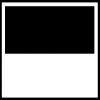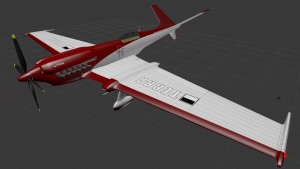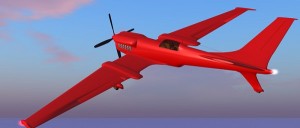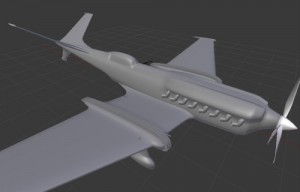
I’m calling it the Terra Atom. That has a kind of mid-century feel that matches my design.
For several days now, I’ve been pretty focused on texturing the new plane I designed for Second Life — that is, creating the surface detail for each and every part in an image editor. Without textures, the plane would look flat and grey, as it did in my previous blog posts.
The quagmire I have to avoid here is getting too concerned with textural detail. It’s possible to keep working on these textures, adding more and more detail, and never finish. Since I’m a little impatient to move this project forward, I’m setting aside the paints and instead focusing on the scripts. Scripts in SL are how you program the detailed behaviour of a vehicle, the user interface, and generally all the functionality that one expects from an airplane.
It’s not a small task, but I have a head-start. With each plane I create, I take my previous flight scripts, menus, visual effects, and more and adapt and improve on them. Every iteration of the flight script that I started in 2005 and carried forward through a dozen or so planes improves the user experience and adds or refines features.
How long does it take to develop a plane from beginning to end? I can’t give you an exact number, since I haven’t tracked my hours, but it seems like an eternity. This particular eternity started in late November (or maybe early December), and will likely continue until March 2015.
The next couple of weeks, however, will be all about coding and testing. Making changes, saving and compiling, and testing the result immediately. If you see Cubey Terra in SL doing a lot of take-offs and landings in a half-finished plane, now you know why.





